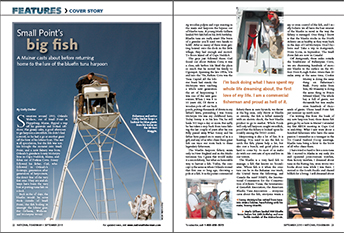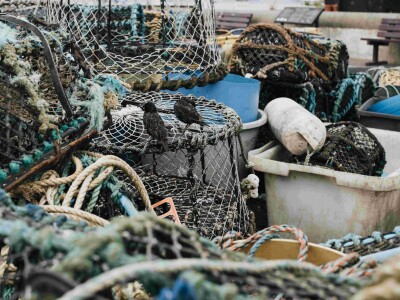Small Point's big fish
A Mainer casts about before returning
home to the lure of the bluefin tuna harpoon
By Corky Decker
Sometime around 1900, Orlando Wallace, out of Small Point in Phippsburg, Maine, flipped a trap off his gunwale and looked offshore. Flat greasy calm, a good afternoon to go harpoon a swordfish. He didn’t find a sword, so he had a go at another giant off the bow of his lobster boat. The rest is all speculation, but the fish was not. He brought the monster into Small Point, and a new fishery was born. Orlando’s grandson Sonny McIntyre lives in Cape Neddick, Maine, and fishes out of Perkins Cove. Sonny followed his father, Carl, who followed in Orlando’s footsteps, generation after generation of harpooners, the direct line of the very first one. They are and always have been the very best at putting tuna fish on a deck.
Back in the ol’ days, the bluefin would be acres thick outside of Small Point, the fish boiling in amongst the lobster gear, the Gilliams, Wallaces and McIntyres would rig wooden pulpits and rope steering in the masts and harpoon the bejesus out of bluefin tuna. A young Merle Gilliam landed 500 fish before his 20th birthday. Bluefin tuna are really smart (the brain of a grander you’ll need two hands to hold). After so many of them were getting hoisted onto the dock in this little village, they had enough and moved. To Boon Island off of Cape Neddick.
The guys just followed them. Carl found out about Perkins Cove; it was a close, safe harbor. He liked the place so much that he moved his family to Ogunquit. Spanning the late 1950s, ’60s and into the ’70s, Perkins Cove was the Tuna Capital. All the lobster boats had stands; the McIntyres were teaching a whole new generation the art of harpooning. I was one of the new generation. When I was 8 to 10 years old, I’d throw a wooden pole off our back porch, putting thousands of divots in my father’s lawn, pretending I was Sonny McIntyre. He was my childhood hero. Today Sonny is in his late 70s; he still hauls 300 traps a day or more. But sadly he has taken a step back from tuna fishing the last couple of years after his son Billy passed away. What Sonny and his father have passed on to many of us is a gift, and any of us who chase these great fish can trace our roots back to these legendary fishermen.
The bluefin harpoon fishery exists only in New England and in the Mediterranean Sea. I guess that would make it a microfishery, but what an honorable way to harvest a fish. Today, the concept is the same as when Orlando ironed that first one so long ago, throwing a pole at a fish. It is the purest commercial fishery there is: zero bycatch; we throw at the big ones, only throw at bluefin or swords; the fish is killed instantly with an electric shock, the best bluefin product to go to market. Whole Foods will only sell harpoon caught swordfish, proof that the fishery is looked upon favorably among the NGO crowd.
Harpooning is also a lot of fun. It is hunting: You need to see the fish to catch the fish; planes help a lot, but also cost a bunch, and good pilots are hard to come by. So most of us make do with our own sets of eyes and live in our towers.
The bluefin is a very hard fish to manage, a fish that knows no boundaries. Whose fish is it when the creature can be in the Bahamas one week, the United States the following, and Canada the next? NMFS, the International Commission for the Conservation of Atlantic Tunas, the International Gamefish Association, the American Bluefin Tuna Association … everyone cares about the fish, everyone wants a say or even control of the fish, and I really believe we all have the best interest of the bluefin in mind in the way the fishery is managed. One thing I know is that the bluefin stocks in the North Atlantic are as healthy as they were back in the days of Carl McIntyre. Don’t believe me? Take a trip to Antigonish, Nova Scotia, in September. The Small Point fish are now in Canada!
Off Antigonish, three miles outside the breakwater of Ballantynes Cove, we are chumming hundreds of monster bluefin to the surface on the 45-foot Novi Rough Rider. More than 20 miles away at the same time, Cookie Murray is doing the same thing on Fisherman’s Bank. Forty miles from him, Ali Hussainy is doing the same thing in Prince Edward Island. The whole bay is full of giants, not thousands but tens maybe even hundreds of thousands of giants. Those Small Point fish just summer up north now.
I’m writing this from the bunk of my new harpoon boat; those damn fish gotta go by us here in Maine! I attended my first ABTA meeting in Cape Cod in mid-May. What I saw were about a hundred fishermen who have the same passion I remember as a teenager in the Tri Coastal Seafood Co-op meetings, bluefin tuna bring a fever to the brow of all who chase them.
I have tried so hard to live a non-tuna life. I moved to Alaska in my early 20s and operated joint-venture trawlers, then factory trawlers. I dreamed about tuna in the Bering Sea, even wrote two books about tuna while I was there. I moved to the South Pacific and chased billfish for a living. I still dreamed about... » Read the full article in our SEPTEMBER issue.








